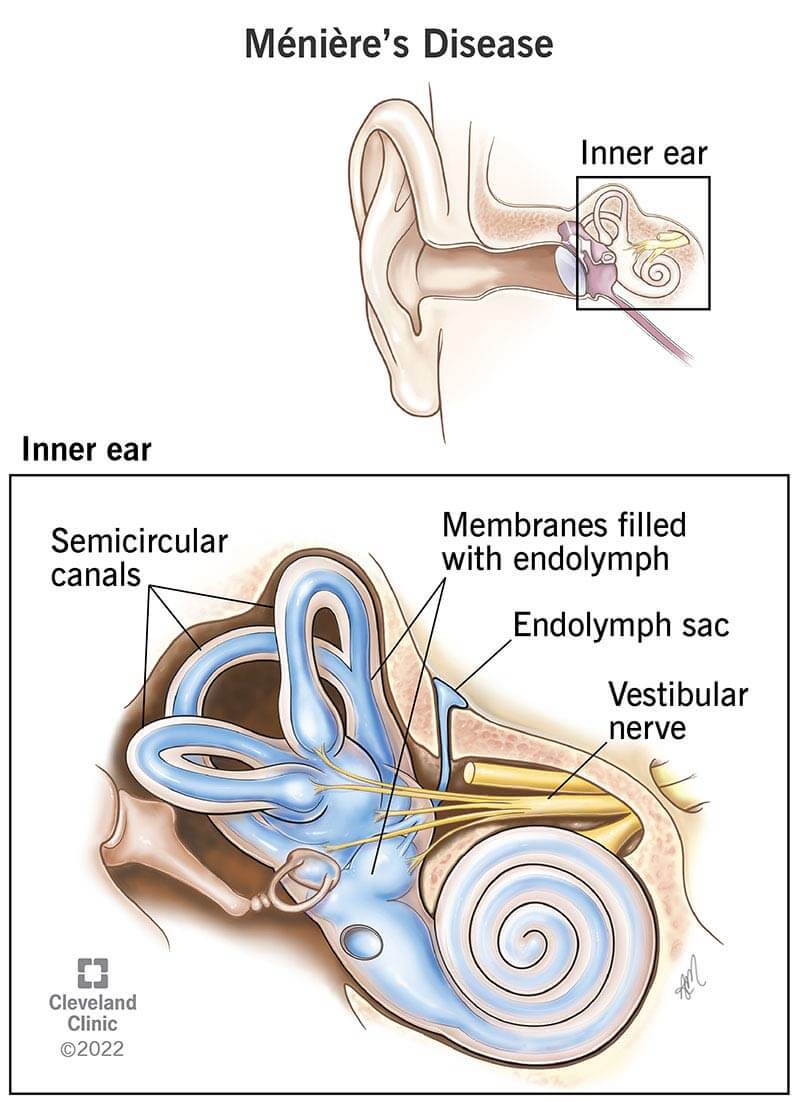Which of the following is an appropriate treatment for Meniere’s disease?
Caffeine-rich beverages.
A low-sodium diet.
High-intensity interval training (HIIT).
Prolonged bed rest.
The Correct Answer is B
Choice A Reason:
Caffeine-rich beverages are not recommended for patients with Meniere’s disease. Caffeine can exacerbate symptoms such as vertigo and tinnitus by increasing the fluid pressure in the inner ear. Therefore, avoiding caffeine is generally advised to help manage the condition.
Choice B Reason:
A low-sodium diet is an appropriate treatment for Meniere’s disease. Reducing sodium intake helps decrease fluid retention in the body, including the inner ear, which can alleviate symptoms such as vertigo, tinnitus, and hearing loss. This dietary modification is a cornerstone of managing Meniere’s disease and can significantly improve the patient’s quality of life.
Choice C Reason:
High-intensity interval training (HIIT) is not suitable for patients with Meniere’s disease. Intense physical activity can trigger vertigo attacks and worsen balance issues. Patients are generally advised to engage in moderate, low-impact exercises that do not provoke symptoms.
Choice D Reason:
Prolonged bed rest is not an appropriate treatment for Meniere’s disease. While rest may be necessary during acute vertigo attacks, long-term bed rest can lead to deconditioning and other health issues. It is important for patients to maintain a balance between rest and activity to manage their symptoms effectively.

Nursing Test Bank
Naxlex Comprehensive Predictor Exams
Related Questions
Correct Answer is A
Explanation
Choice A Reason:
Tilting the head to the side and pulling the earlobe up and back is the recommended method for adults to straighten the ear canal, allowing the drops to flow directly into the ear canal and reach the site of infection effectively. This method ensures that the medication is properly administered and can work effectively to treat the infection.
Choice B Reason:
Laying flat on your back and placing the drops on a cotton ball before inserting it into the ear canal is not a recommended method for administering ear drops. This method can prevent the medication from reaching the ear canal properly and may not be as effective in treating the infection. Additionally, using a cotton ball can absorb the medication, reducing its effectiveness.
Choice C Reason:
Tilting the head to the side and pulling the earlobe down and back is the correct method for administering ear drops to children under three years old. For adults, this method is not recommended as it does not straighten the ear canal properly, which can prevent the medication from reaching the site of infection effectively.
Choice D Reason:
Tilting the head forward and pulling the earlobe up and forward is not a recommended method for administering ear drops. This method does not properly straighten the ear canal and can prevent the medication from reaching the site of infection. It is important to follow the correct technique to ensure the medication is effective.
Correct Answer is C
Explanation
Choice A Reason:
Administering intravenous fluids is not the most appropriate initial action for managing hypopituitarism. While IV fluids may be necessary in cases of acute adrenal crisis or severe dehydration, they do not address the underlying hormone deficiencies caused by hypopituitarism. The primary treatment focuses on replacing the deficient hormones to restore normal physiological functions.
Choice B Reason:
Performing a transsphenoidal hypophysectomy is a surgical procedure used to remove pituitary tumors. While this may be necessary if a tumor is causing hypopituitarism, it is not the initial action for managing the condition. The first step is to stabilize the patient with hormone replacement therapy before considering surgical interventions.
Choice C Reason:
Initiating hormone replacement therapy is the most appropriate initial action for managing hypopituitarism. This condition results in the deficiency of one or more pituitary hormones, and replacing these hormones is crucial to restore normal body functions. Hormone replacement therapy may include cortisol, thyroid hormone, sex hormones, and growth hormone, depending on which hormones are deficient.
Choice D Reason:
Recommending dietary modifications alone is not sufficient to manage hypopituitarism. While a balanced diet can support overall health, it does not address the specific hormone deficiencies associated with this condition. Hormone replacement therapy is essential for managing hypopituitarism effectively.
Whether you are a student looking to ace your exams or a practicing nurse seeking to enhance your expertise , our nursing education contents will empower you with the confidence and competence to make a difference in the lives of patients and become a respected leader in the healthcare field.
Visit Naxlex, invest in your future and unlock endless possibilities with our unparalleled nursing education contents today
Report Wrong Answer on the Current Question
Do you disagree with the answer? If yes, what is your expected answer? Explain.
Kindly be descriptive with the issue you are facing.
